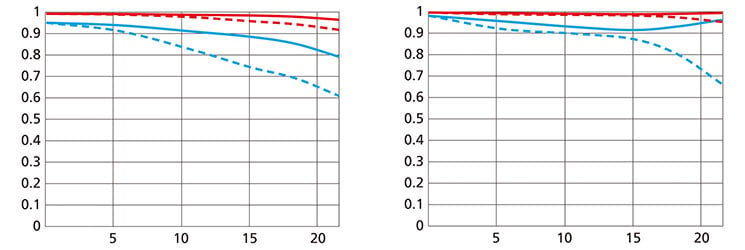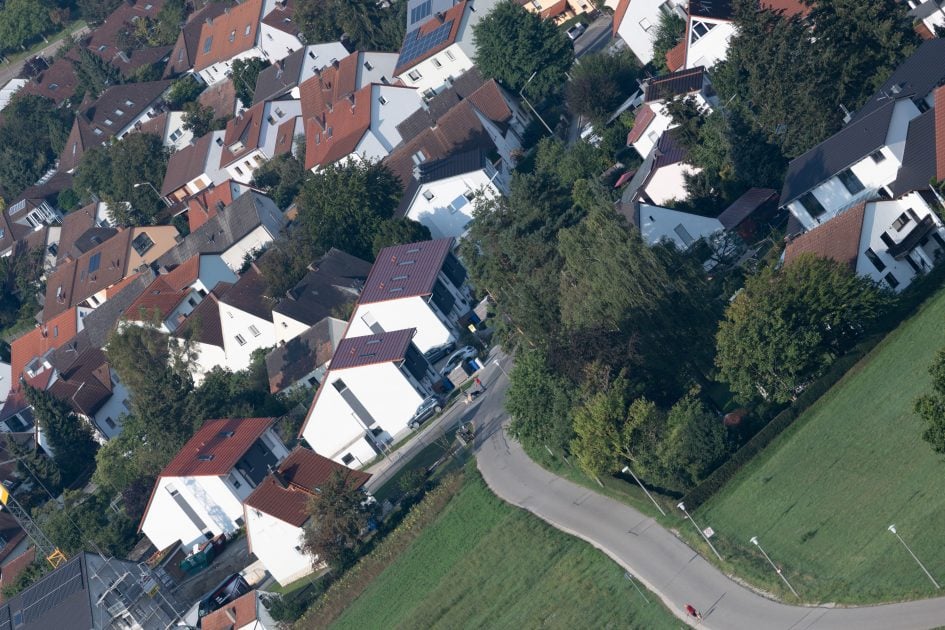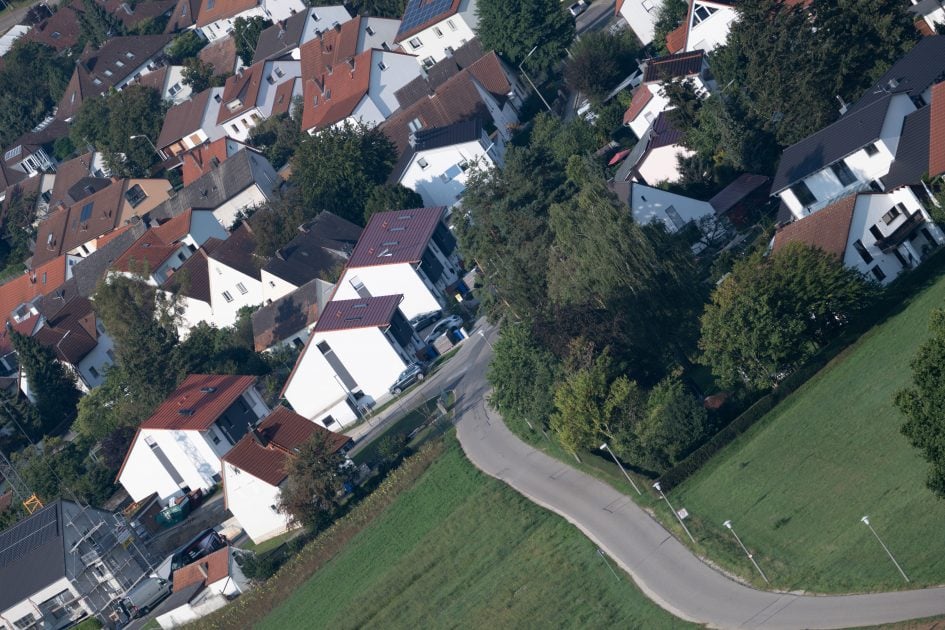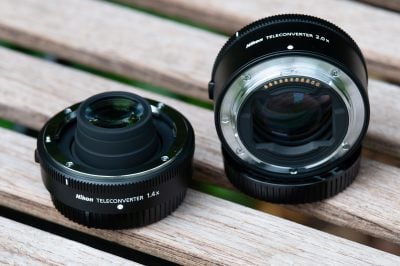Nikon Z TC-1.4x TC-2.0x teleconverter review
-
-
Written by Thomas
Quality
Sharpness and contrast
Every teleconverter acts as a loupe/microscope on the performance of the lens attached to it. This makes any lens look worse than it looks without a teleconverter. Let’s have a look at the theoretical performance of the new Nikon Z 70-200mm f2.8 VR S, an excellent lens, which earned a Highly Recommended in my review:

Above: MTF Nikon Z 70-200mm f2.8 VR S at 70mm, f2.8 (left) and 200mm, f2.8 (right)
These MTF (modulation transfer function) charts show the computed lens-performance of lenses wide open without influence of diffraction. Higher values mean more contrast and thus higher perceived sharpness. As contrast of a lens degrades with the frequency of the modulation finer patterns appear less sharp than coarser ones. Thus the red lines for 10 pairs of black and white lines per millimeter show higher contrast than the petrol lines for 30 line-pairs per mm (lp/mm).
Let’s say we attach a (theoretical) 3x teleconverter to this lens. Suddenly the pattern of 30 lp/mm is magnified by 3x and appears as 10 lp/mm. Even if this 3x teleconverter is optically perfect, it reduces the 10 lp/mm contrast of the lens + TC to the 30 lp/mm contrast of the lens alone. Fortunately the teleconverter also reduces the field of view thus the less sharp outer areas are cut off. In our case of the theoretical 3x TC only the inner 14mm image circle (21/3=7mm image height) is used and magnified to give the full-frame picture. But still: contrast/resolution is lower than without TC. This is an important point to keep in mind when judging and comparing images shot with or without teleconverters.
Now let’s see how this theoretical performance translates into real life results in the sharpness test based on Siemens-stars. Processing was done in Lightroom 9.4/CRAW 12.4 from RAW to Adobe Color profile with the built-in lens profile applied (Vignette control=N, Diffraction compensation=OFF, Auto distortion control=ON). Noise-reduction is set to 0, sharpening to 50/0.5/36/10, with no extra tone, color, or saturation adjustment. White-balance was adjusted to a neutral white and I did some exposure compensation to make the brightness of all crops match. So you will not see light fall-off in the corners.
The following are all 100% crops!
I’ve arranged the results by focal length and included the crops from the Nikon Z 70-200mm f2.8 VR S alone (without TC), with TC-1.4x, and with TC-2.0x where applicable. In my first set all combos are shown at the largest available aperture – i.e. with the lens set to f2.8.
Nikon Z 70-200mm f2.8 VR S; 100% crop from center, DX-corner, FX-corner
Above: without TC at 70mm, f2.8
Above: without TC at 100mm, f2.8

Above: with TC-1.4x at 98mm, f4.0
Above: without TC at 140mm, f2.8

Above: with TC-1.4x at 140mm, f4.0

Above: with TC-2.0x at 140mm, f5.6
Above: without TC at 200mm, f2.8

Above: with TC-1.4x at 200mm, f4.0

Above: with TC-2.0x at 200mm, f5.6

Above: with TC-1.4x at 280mm, f4.0

Above: with TC-2.0x at 280mm, f5.6

Above: with TC-2.0x at 400mm, f5.6
The results above show that the use of teleconverters degrades performance of the Nikon Z 70-200mm f2.8 VR S only slightly – up to 200mm focal length. But even at 280mm and 400mm the gradual softening is not too bad and could be countered by a bit more aggressive sharpening with a larger radius.
If you want to see all the details and comparisons at smaller apertures, read on. Or you can fast-forward to the performance at long distances.
In my second set all combos are shown at f5.6 and f8.0. So now we have a real apples-to-apples comparison.
Performance at 100mm, f5.6 and f8.0:
Above: without TC at 100mm, f5.6

Above: with TC-1.4x at 98mm, f5.6

Above: without TC at 100mm, f8.0

Above: with TC-1.4x at 98mm, f8.0
Very good results with or without TC at 100mm.
Performance at 140mm, f5.6 and f8.0:
Above: without TC at 140mm, f5.6

Above: with TC-1.4x at 140mm, f5.6

Above: with TC-2.0x at 140mm, f5.6

Above: without TC at 140mm, f8.0

Above: with TC-1.4x at 140mm, f8.0

Above: with TC-2.0x at 140mm, f8.0
At 140mm focal length the TC-2.0x is clearly softest at f5.6. But at f8.0 the differences are minimal.
Performance at 200mm, f5.6 and f8.0:
Above: without TC at 200mm, f5.6

Above: with TC-1.4x at 200mm, f5.6

Above: with TC-2.0x at 200mm, f5.6

Above: without TC at 200mm, f8.0

Above: with TC-1.4x at 200mm, f8.0

Above: with TC-2.0x at 200mm, f8.0
At 200mm the results with TC-1.4x are very close to the lens without TC but the TC-2.0x is a tad softer at f5.6. Again: stopping down to f8.0 minimizes the differences to almost negligible.
Performance at 280mm, f5.6 and f8.0:

Above: with TC-1.4x at 280mm, f5.6

Above: with TC-2.0x at 280mm, f5.6

Above: with TC-1.4x at 280mm, f8.0

Above: with TC-2.0x at 280mm, f8.0
At 280mm focal length and f5.6 the combo with the TC-2.0x loses a bit of overall contrast through a slight haze, probably from residual spherical aberrations. Stopping down to f8.0 reduces this problem.
Performance at 400mm, f5.6 – f11:

Above: with TC-2.0x at 400mm, f5.6

Above: with TC-2.0x at 400mm, f8.0

Above: with TC-2.0x at 400mm, f11
At the longest focal length of 400mm the combo of Nikon’s Z 70-200mm f2.8 VR S and TC-2.0x again shows a bit of haze at f5.6 which is clearly reduced by stopping down to f8.0. Stopping further down to f11 does not improve acuity as softening from diffraction is already setting in.
Overall Nikon’s new teleconverters in combination with the Z 70-200mm f2.8 VR S zoom lens show very convincing performance – not as good as the zoom lens alone but still surprisingly sharp and contrasty.
Performance at long distances
The Siemens-star test-targets are shot at a distance of 45x focal length (i.e. at around 6m for 140mm focal length). But performance of lenses also depends on the shooting distance. Therefore I present another series of test-shots of a city around 1 km away. Processing was done in Lightroom 9.4/CRAW 12.4 from RAW to Adobe Color profile with the lens-profile for distortion and vignetting automatically applied. Noise-reduction is set to 0, sharpening to 50/0.5/36/10, with no extra tone, color, or saturation adjustment. I used manual focus at the largest aperture and did not change focus for other apertures. All shots were made at ISO 64 and image stabilization switched off.
The following are all 100% crops!
I’ve arranged the results by focal length and included the crops from the Nikon Z 70-200mm f2.8 VR S alone (without TC), with TC-1.4x, and with TC-2.0x where applicable. In my first set all combos are shown at the largest available aperture – i.e. with the lens set to f2.8.
As usual I have selected the diagonal that provided the better corner results as almost any lens is a bit decentered.
You can access the large originals but please respect our copyright and only use those images for personal use.
Nikon Z 70-200mm f2.8 VR S; 100% crop from center, DX-corner, FX-corner
Above: without TC at 70mm, f2.8; click image for 4k version, here for large original
Above: without TC at 100mm, f2.8; click image for 4k version, here for large original
Above: with TC-1.4x at 98mm, f4.0; click image for 4k version, here for large original
Above: without TC at 140mm, f2.8; click image for 4k version, here for large original
Above: with TC-1.4x at 140mm, f4.0; click image for 4k version, here for large original
Above: with TC-2.0x at 140mm, f5.6; click image for 4k version, here for large original
Above: without TC at 200mm, f2.8; click image for 4k version, here for large original
Above: with TC-1.4x at 200mm, f4.0; click image for 4k version, here for large original
Above: with TC-2.0x at 200mm, f5.6; click image for 4k version, here for large original
Above: with TC-1.4x at 280mm, f4.0; click image for 4k version, here for large original
Above: with TC-2.0x at 280mm, f5.6; click image for 4k version, here for large original
Above: with TC-2.0x at 400mm, f5.6; click image for 4k version, here for large original
Some remarks and observations:
- At 98mm the DX-corner with TC-1.4x shows reduced contrast compared to the shot w/o TC.
- At 140mm the shot with TC-1.4x is pretty close to the shot w/o TC but the shot with TC-2.0x is clearly softer, especially in the DX-corner.
- At 200mm the shots with and without TC-1.4x are very close while the shot with TC-2.0x is getting progressively softer towards the corners.
- At 280mm the shot with TC-1.4x at f4.0 is clearly sharper across the sensor than from the TC-2.0x at f5.6.
The results above show that the use of the TC-1.4x holds up performance quite well with only little degradation compared to the “naked” lens. The TC-2.0x produces very usable results but is visibly softer in comparison.
In my second set all combos are shown at f5.6 and f8.0 for an apples-to-apples comparison. And at the end I’ve added a comparison of the results from the TC-1.4x at 280mm cropped to match 400mm with the results from the TC-2.0x at 400mm.
If you want to see all the details and comparisons at smaller apertures, read on. Or fast-forward to the next chapter on close-up performance.
Performance at 100mm, f5.6 and f8.0:
Above: without TC at 100mm, f5.6

Above: with TC-1.4x at 98mm, f5.6

Above: without TC at 100mm, f8.0

Above: with TC-1.4x at 98mm, f8.0
The results are almost indistinguishable at 100mm – with or without TC.
Performance at 140mm, f5.6 and f8.0:
Above: without TC at 140mm, f5.6

Above: with TC-1.4x at 140mm, f5.6

Above: with TC-2.0x at 140mm, f5.6

Above: without TC at 140mm, f8.0

Above: with TC-1.4x at 140mm, f8.0

Above: with TC-2.0x at 140mm, f8.0
When all combos are at f5.6 the softer performance with the TC-2.0x becomes even more obvious. Stopping down to f8.0 improves performance with the TC-2.0x visibly.
Performance at 200mm, f5.6 and f8.0:
Above: without TC at 200mm, f5.6

Above: with TC-1.4x at 200mm, f5.6

Above: with TC-2.0x at 200mm, f5.6

Above: without TC at 200mm, f8.0

Above: with TC-1.4x at 200mm, f8.0

Above: with TC-2.0x at 200mm, f8.0
At 200mm the combo with TC-2.0x again profits from stopping down to f8.0.
Performance at 280mm, f5.6 and f8.0:

Above: with TC-1.4x at 280mm, f5.6

Above: with TC-2.0x at 280mm, f5.6

Above: with TC-1.4x at 280mm, f8.0

Above: with TC-2.0x at 280mm, f8.0
At 280mm focal length the combo with the TC-2.0x produces very usable results already at f5.6. But stopping down to f8.0 lifts acuity in the DX image-circle visibly.
Performance at 400mm, f5.6 – f11:

Above: with TC-2.0x at 400mm, f5.6

Above: with TC-2.0x at 400mm, f8.0

Above: with TC-2.0x at 400mm, f11
At the longest focal length of 400mm the combo of Nikon’s Z 70-200mm f2.8 VR S and TC-2.0x again delivers quite good resolution in the DX image-circle even at f5.6 – but does not gain much by stopping down.
In this long distance test Nikon’s new teleconverters in combination with the Z 70-200mm f2.8 VR S zoom lens look slightly different than in the first test: The TC-1.4x again delivers performance that is pretty close to the naked lens but the TC-2.0x mostly looks a bit softer. This might not be the TC’s fault but may simply indicate that you can see the resolution limit of the Z 70-200mm f2.8 VR S at long distances when magnified 2x.
So if you only need to reach 280mm focal length the TC-1.4x is clearly the better choice – especially as it gives you another stop of light-gathering power over a solution with the TC-2.0x. And you can always crop. But how good are the results from cropping?
Performance at 400mm cropped:
If you need 400mm but only have the TC-1.4x can you achieve comparable results from cropping into the image to get the same angle-of-view as with the TC-2.0x?
Cropping a 45MP shot at 280mm to match the angle-of-view at 400mm still nets you around 23MP. If the image at 280mm is sharp enough this might well be enough for the intended purpose. Here is an example from the Z 70-200mm f2.8 VR S with TC-1.4x at 280mm cropped to match the shot with TC-2.0x at 400mm. To make the 400mm shot comparable when viewed at 100% I downsized the image to 71% of the original size with Photoshop. Now both images are 5862 px wide and 3908 px high. That’s a little larger still than a DX-crop on a Z7 and is good enough to print 24 inches wide at 240 dpi.
Above: Z 70-200mm f2.8 VR S with TC-1.4x shot at 280mm f5.6, cropped to match image below; click image for 5862×3908 px version
Above: Z 70-200mm f2.8 VR S with TC-2.0x shot at 400mm f5.6, resized to match image above; click image for 5862×3908 px version
To make it easier to compare contrast and sharpness I’ve extracted the usual 100% crops from both images. Keep in mind though that the crops from the downsized 400mm shot now show a larger area of the image than in the paragraph “Performance at 400mm, f5.6 – f11” above.

Above: with TC-1.4x at 280mm f5.6, cropped to 400mm angle-of-view

Above: with TC-2.0x at 400mm f5.6, resized to match image above
If you look closely the shot with TC-2.0x is a bit sharper in the center, almost indistinguishable in the DX-corner and softer in the FX-corner. But both results are so close that at normal viewing distances you wouldn’t see a difference between both images. So yes: The combination of Nikon’s Z 70-200mm f2.8 VR S and the Z TC-1.4x is easily good enough to crop the resulting images right up to a 400mm angle-of-view. Which is quite a feat!
Close-up performance
When using the Z 70-200mm f2.8 VR S with one of the new Z TCs you can go down to 1:3.3 resp. 1:2.4 magnification which is pretty impressive. Testing the combination of lens + TC with the lens at 70mm or 200mm focal length revealed that sharpness was better with the lens at the short end. So I used the lens set to 70mm in all of the following test-shots.
The following images were shot with the TC-1.4x at 1:3.4 magnification where the area of sharp focus is 122 x 82mm. The crops shown below are from 0mm, 12mm, and 20mm off the center of the sensor respectively:

Above: Nikon Z 70-200mm f2.8 VR S with TC-1.4x at 98mm, f4.0; 100% crops

Above: Nikon Z 70-200mm f2.8 VR S with TC-1.4x at 98mm, f8.0; 100% crops

Above: Nikon Z 70-200mm f2.8 VR S with TC-1.4x at 98mm, f11.0; 100% crops
The combo with the TC-1.4x produces good results in the center already at f4.0. But you need to stop down to f8.0 at least to extend this sharpness into the DX-corner.
The following images were shot with the TC-2.0x at 1:2.4 magnification where the area of sharp focus is just 86 x 58mm. The crops shown below are from 0mm, 12mm, and 20mm off the center of the sensor respectively:

Above: Nikon Z 70-200mm f2.8 VR S with TC-2.0x at 140mm, f5.6; 100% crops

Above: Nikon Z 70-200mm f2.8 VR S with TC-2.0x at 140mm, f8.0; 100% crops

Above: Nikon Z 70-200mm f2.8 VR S with TC-2.0x at 140mm, f11; 100% crops
With the TC-2.0x results are a bit softer at the highest magnification. The center is usable at f5.6 but I’d suggest to stop down to f11 for better overall results.
Next check out my sample images!
Check prices on the Nikon Z TC 1.4x at Amazon, B&H, Adorama or WEX! Check prices on the Nikon Z TC 2x at B&H, Adorama or WEX. Alternatively get yourself a copy of my In Camera book or treat me to a coffee! Thanks!























